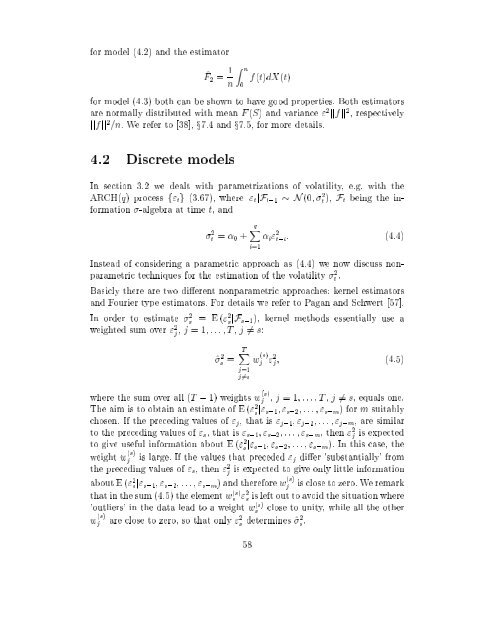Estimation in Financial Models - RiskLab
Estimation in Financial Models - RiskLab
Estimation in Financial Models - RiskLab
Create successful ePaper yourself
Turn your PDF publications into a flip-book with our unique Google optimized e-Paper software.
for model (4.2) and the estimator<br />
^F 2 = 1 n<br />
Z n<br />
0<br />
f(t)dX(t)<br />
for model (4.3) both can be shown to have good properties. Both estimators<br />
are normally distributed with mean F (S) and variance " 2 jjfjj 2 , respectively<br />
jjfjj 2 =n. We refer to [38], x7.4 and x7.5, for more details.<br />
4.2 Discrete models<br />
In section 3.2 we dealt with parametrizations of volatility, e.g. with the<br />
ARCH(q) process f" t g (3.67), where " t jF t,1 N (0;t 2 ), F t be<strong>in</strong>g the <strong>in</strong>formation<br />
-algebra at time t, and<br />
2 t = 0 +<br />
qX<br />
i=1<br />
i " 2 t,i: (4.4)<br />
Instead of consider<strong>in</strong>g a parametric approach as (4.4) we now discuss nonparametric<br />
techniques for the estimation of the volatility 2 t .<br />
Basicly there are two dierent nonparametric approaches: kernel estimators<br />
and Fourier type estimators. For details we refer to Pagan and Schwert [57].<br />
In order to estimate s<br />
2 = E(" 2 sjF s,1 ), kernel methods essentially use a<br />
weighted sum over " 2 j, j =1;:::;T, j 6= s:<br />
^ 2 s =<br />
TX<br />
j=1<br />
j6=s<br />
w (s)<br />
j " 2 j; (4.5)<br />
where the sum over all (T , 1) weights w (s)<br />
j , j =1;:::;T, j 6= s, equals one.<br />
The aim is to obta<strong>in</strong> an estimate of E (" 2 sj" s,1 ;" s,2 ;:::;" s,m ) for m suitably<br />
chosen. If the preced<strong>in</strong>g values of " j , that is " j,1 ;" j,2 ;:::;" j,m , are similar<br />
to the preced<strong>in</strong>g values of " s , that is " s,1 ;" s,2 ;:::;" s,m , then " 2 j is expected<br />
to give useful <strong>in</strong>formation about E(" 2 sj" s,1 ;" s,2 ;:::;" s,m ). In this case, the<br />
weight w (s)<br />
j is large. If the values that preceded " j dier 'substantially' from<br />
the preced<strong>in</strong>g values of " s , then " 2 j is expected to give only little <strong>in</strong>formation<br />
about E (" 2 sj" s,1 ;" s,2 ;:::;" s,m ) and therefore w (s)<br />
j is close to zero. We remark<br />
that <strong>in</strong> the sum (4.5) the element w s<br />
(s) " 2 s is left out to avoid the situation where<br />
'outliers' <strong>in</strong> the data lead to a weight w s<br />
(s) close to unity, while all the other<br />
w (s)<br />
j are close to zero, so that only " 2 s determ<strong>in</strong>es ^ s.<br />
2<br />
58
















